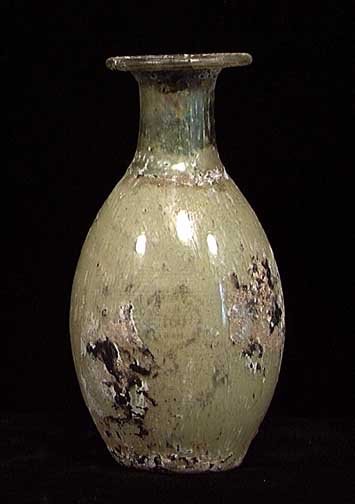
|
|

|
YOU ARE HERE:>>Real or Fake>>Fake ancient glass
Ancient glass can be, but need not be, a pit-fall for new collectors.
- There are fakes of ancient glass on the maket and many pieces which have been heavily restored, with the restoration hidden and disguised.
- Beware of sandy deposits which do not brush off. This could well be new sand sprinkled on the glue around an area of repair or restoration.
- A fibre-optic light which allows you to look inside the vessel is a very handy little tool.
With thanks to Edgar L Owen
A 'ROMAN' GLASS BOTTLE (made in Hungary). This example of Roman glass didn't look right to us. When we cleaned the fake patina, we found the body was a Hungarian light bulb-160 watts. The neck is original Roman glass. An interesting object to add to your 'black museum' of fakes. $10 estimate. SOLD



These are rather dreadful fakes. However the faker's art is often rather more sophsticated than shown here.
Another thing to watch out for.
Is this an unusual and rare variation of a known type?
No!!
Believe your eyes, not the story.
Don't listen to the story, look a the object!
We can all make mistakes like this.
By portland
- There is no conclusive scientific test that can verify the age of glass. Unfortunately carbon dating does not work on glass. However, all is not lost.
- The Corning Museum of Glass has collected 10,000 items or fragments of ancient glass which they have chemically analyzed. Their findings are published in BRILL - Chemical Analyses of Early Glasses. The use of this is that a picture is built up of the chemical constituents and ingredients of ancient glass from specific areas and for specific types. This is a great help in scientific verification of glass. Furthermore it can tell you about colour elements and combinations of colour found in glass. A scientific analyses can be made by taking a miniscule fragment from the glass and analyzing it in a spectrometer. Similarly with engraving on glass, an experienced person can tell under a microscope if the engraving was cut at the time of manufacture or in modern times.
- We don't need to have a scientific degree to be able to make simple eye judgements to detect imposters. By observing in museums or books the various matrix or glass canes used in ancient mosaic glass, or colour combinations and trails used in ancient core-glass, we can make comparisons and judgement of glass on offer. When fakes are made they often use a combination of modern mass produced colour canes which have no parallel in ancient glass. So if you study carefully the combination pattern of canes in ancient glass with something offered in the antiquities market you will have a good yardstick from which to work.
- Not all Roman looking glass was intended to deceive. Mosaic glass has been made in Murano for centuries and whilst some made in the 19th century lloks very much like Roman glass. if you exammine carefully the patterms of the "flowers" in the mosaic, you will see that they are of a different cane combination from that of the Romans. This is just the Venetians continuing the ancient tradition of millefiori glass .
- As for weathering/patination/iridescence, a glass conservationist can tell by looking at the glass under microscope whether the piece has natural weathering of if it has been artificially induced. Unfortunately sometimes acid used to clean glass removes the original true weathered surface and therefore makes it more difficult to authenticate. The latter point is at the hub or the argument to clean or not to clean?


Home | About This Site | Privacy Statement | Gallery | Testimonials | Guarantees
About Collectors' Resources pages | What's New
Search | Site Map | Contact Us